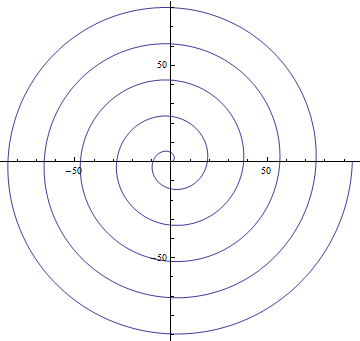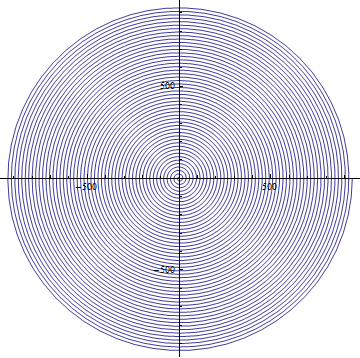.
Archimedean spiral
The Archimedean spiral (also known as the arithmetic spiral) is a spiral named after the 3rd century BC Greek mathematician Archimedes. It is the locus of points corresponding to the locations over time of a point moving away from a fixed point with a constant speed along a line which rotates with constant angular velocity. Equivalently, in polar coordinates (r, θ) it can be described by the equation
\( \, r=a+b\theta \)
with real numbers a and b. Changing the parameter a will turn the spiral, while b controls the distance between successive turnings.

Examples: Archimedes Spiral (Mathematica , PolarPlot[ 3 t, {t, 0, 10 Pi}] )

Examples: Archimedes Spiral (Mathematica , PolarPlot[ 3 t, {t, 0, 100 Pi}] )
Archimedes described such a spiral in his book On Spirals.
Characteristics
The Archimedean spiral has the property that any ray from the origin intersects successive turnings of the spiral in points with a constant separation distance (equal to 2πb if θ is measured in radians), hence the name "arithmetic spiral".
In contrast to this, in a logarithmic spiral these distances, as well as the distances of the intersection points measured from the origin, form a geometric progression.
The Archimedean spiral has two arms, one for θ > 0 and one for θ < 0. The two arms are smoothly connected at the origin. Only one arm is shown on the accompanying graph. Taking the mirror image of this arm across the y-axis will yield the other arm.
Separation distance between turns
Some sources describe the Archimedean spiral as a spiral with a "constant separation distance" between successive turns.[1] This is somewhat misleading. The constant distances in the Archimedean spiral are measured along rays from the origin which do not cross the curve at right angles, whereas a distance between parallel curves is measured orthogonally to both curves. There is a curve slightly different from the Archimedean spiral, the involute of a circle, whose turns have constant separation distance in the latter sense of parallel curves.
General Archimedean spiral
Sometimes the term Archimedean spiral is used for the more general group of spirals
\( r=a+b\theta^{1\!/\!x}. \)
The normal Archimedean spiral occurs when x = 1. Other spirals falling into this group include the hyperbolic spiral, Fermat's spiral, and the lituus. Virtually all static spirals appearing in nature are logarithmic spirals, not Archimedean ones. Many dynamic spirals (such as the Parker spiral of the solar wind, or the pattern made by a Catherine's wheel) are Archimedean.
Applications
One method of squaring the circle, by relaxing the strict limitations on the use of straightedge and compass in ancient Greek geometric proofs, makes use of an Archimedean spiral.
Mechanism of a scroll pump
The Archimedean spiral has a variety of real-world applications. Scroll compressors, made from two interleaved Archimedean spirals of the same size, are used for compressing liquids and gases.[2] The coils of watch balance springs and the grooves of very early gramophone records form Archimedean spirals, making the grooves evenly spaced and maximizing the amount of music that could be fit onto the record (although this was later changed to allow better sound quality).[3] Asking for a patient to draw an Archimedean spiral is a way of quantifying human tremor; this information helps in diagnosing neurological diseases. Archimedean spirals are also used in digital light processing (DLP) projection systems to minimize the "rainbow effect"[citation needed], making it look as if multiple colors are displayed at the same time, when in reality red, green, and blue are being cycled extremely quickly.[4] Also, Archimedean spirals are used in food microbiology to quantify bacterial concentration through a spiral platter.[5] And it's also used to model the pattern that occurs in a roll of paper or tape of constant thickness wrapped around a cylinder.[6][7]
See also
Hyperbolic spiral
Fermat's spiral
Logarithmic spiral
Triple spiral symbol
References
^ "successive turnings of the Archimedean spiral have a constant separation distance" Havil, Julian (2007). Nonplussed! Mathematical Proof of Implausible Ideas. Princeton, New Jersey: Princeton Universoty Press. p. 109. ISBN 978-0-691-12056-0.
^ Sakata, Hirotsugu and Masayuki Okuda. "Fluid compressing device having coaxial spiral members". Retrieved 2006-11-25.
^ Penndorf, Ron. "Early Development of the LP". Retrieved 2005-11-25.. See the passage on Variable Groove.
^ Wilson, Tracy V.. "Adding Color and the Reliability of DLP". Retrieved 2005-11-25.
^ J. E. Gilchrist, J. E. Campbell, C. B. Donnelly, J. T. Peeler, and J. M. Delaney. "Spiral Plate Method for Bacterial Determination".
^ http://mtl.math.uiuc.edu/special_presentations/JoansPaperRollProblem.pdf
^ http://books.google.com.br/books?id=rU8jvsJMKsgC&pg=PA27&lpg=PA27&dq=paper+roll+thickness+archimedean+spiral&source=bl&ots=u7v-HK6_8M&sig=8UMxhOaMY8NM7XrS-2YEE1cTCTY&hl=pt-BR&sa=X&ei=ae_sTsDTJ8q2twf2woS-Cg&ved=0CE4Q6AEwBQ#v=onepage&q=paper%20roll%20thickness%20archimedean%20spiral&f=false
External links
Weisstein, Eric W., "Archimedes' Spiral" from MathWorld.
archimedean spiral at PlanetMath
Page with Java application to interactively explore the Archimedean spiral and its related curves
Online exploration using JSXGraph (JavaScript)
Retrieved from "http://en.wikipedia.org/"
All text is available under the terms of the GNU Free Documentation License

